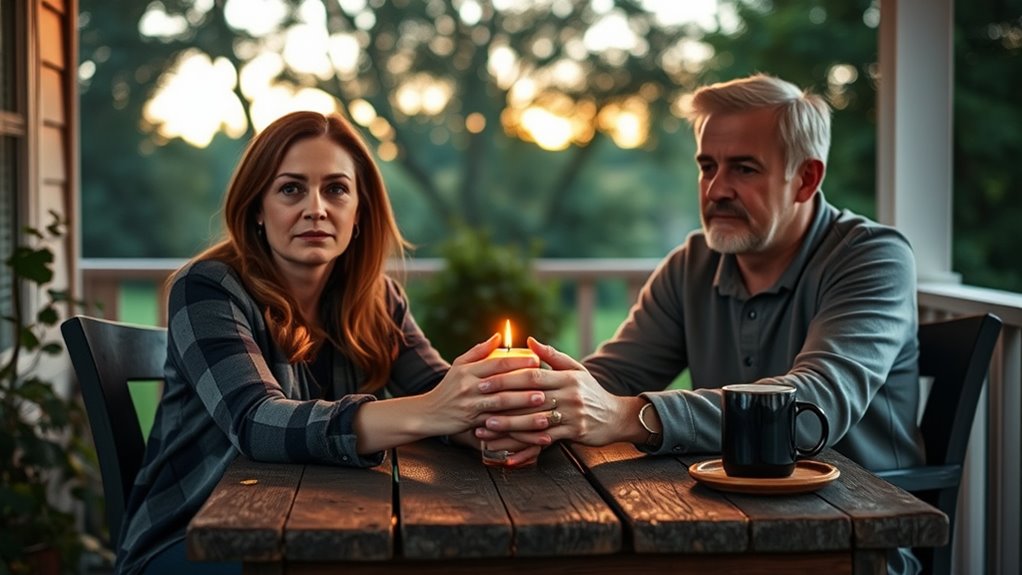Being married to someone with BPD requires patience, open communication, and strong boundaries. Focus on validating their feelings, establishing honest dialogue, and maintaining consistency to build trust. Support healthy habits like therapy, routines, and self-care. Be prepared for emotional fluctuations and cycles, but stay resilient together. Creating a support network and setting clear limits helps protect your relationship’s stability. For more strategies to nurture your bond, explore key approaches to managing BPD challenges effectively.
Key Takeaways
- Foster open, honest communication and validate your partner’s feelings to build trust and emotional safety.
- Establish clear boundaries and consistent routines to manage emotional instability and prevent misunderstandings.
- Practice patience, understanding, and mutual effort during emotional swings to strengthen your relationship.
- Support healthy habits like therapy, self-care, and stress management to promote stability and resilience.
- Build a strong support network through therapy groups and resources to navigate challenges effectively.
Understanding BPD and Its Impact on Relationships

Understanding BPD and its impact on relationships is essential if you’re steering a connection with someone who has this disorder. BPD causes instability in moods, self-image, and behaviors, which can challenge relationship harmony. You might notice intense emotional swings and a deep fear of abandonment that trigger conflict and insecurity. These symptoms often lead to chaotic, conflict-filled interactions, with frequent breakups and reconciliations. Partners may feel stressed, struggle with communication, or worry about trust and honesty, even if lying isn’t a formal symptom. This disorder amplifies hostility and emotional dysregulation, making interactions unpredictable. Recognizing how BPD influences emotional responses and relationship dynamics helps you approach your partner with understanding, patience, and strategies that support stability and growth. BPD symptoms are linked to lower relationship satisfaction for partners, which underscores the importance of awareness and supportive approaches in maintaining healthy connections. Additionally, understanding the underlying causes of emotional dysregulation can help in developing effective coping strategies.
Recognizing Emotional Fluctuations and Responding Effectively

Emotional fluctuations in individuals with BPD can be sudden and intense, often shifting from feelings of happiness to deep anxiety within hours. You might notice your partner viewing you as “the one,” only to experience a sharp mood drop and hypersensitivity soon after. These swings can last hours or days, making it hard to predict reactions. Symptoms like fear of abandonment or hypersensitivity to minor incidents—missed texts or canceled plans—can trigger emotional upheaval. Hypervigilance to rejection fuels push-pull behaviors, adding tension. Mood swings are often driven by internal self-criticism and blame, not intentional harm. Be alert to these signs: – Sudden withdrawal after closeness – Overreacting to routine changes – Paranoid thoughts about abandonment – Irritability disproportionate to events – Over-analyzing interactions, leading to misinterpretations. Recognizing that these emotional shifts are rooted in internal self-regulation struggles and understanding their connection to lifestyle factors can help foster understanding and patience during turbulent times.
Building Trust Through Open and Honest Communication

Building trust with someone who has BPD starts with open and honest communication. You should express your feelings clearly, helping to create a solid foundation of trust. Practice active listening by paying close attention without interrupting, demonstrating you value their perspective. Validating their emotions shows respect and understanding, making them feel heard. Be transparent about your needs and concerns, fostering a safe space for sharing. Regular check-ins keep communication flowing and help address issues early. Set and respect boundaries by establishing clear limits about time and space, and communicate these boundaries openly. Consistency is key—follow through on promises, be punctual, and respond promptly. These practices build reliability, emotional safety, and trust, strengthening your relationship over time. Consistent effort is essential to reinforce trust and demonstrate your commitment to the relationship. Additionally, understanding the importance of trust-building strategies can help you navigate the complexities of a relationship involving BPD. Incorporating reliable communication methods, such as scheduled conversations or written notes, can further enhance mutual understanding and security. Engaging in activities that promote water-based relaxation can also reduce stress and foster emotional connection between partners. Developing an awareness of AI in Education can provide insights into how personalized approaches might be applied to support emotional and educational growth within relationships. Recognizing emotional manipulation tactics used by narcissists can help you identify and protect yourself from potential harm.
Navigating the Cycles of Idealization and Devaluation

The cycles of idealization and devaluation are common challenges in relationships involving someone with BPD, often causing confusion and emotional turmoil. You might feel elated when your partner idealizes you, only to be shattered when they suddenly devalue you. Recognizing these patterns helps you stay grounded. You can:
Cycles of idealization and devaluation in BPD relationships can cause confusion; recognizing them helps maintain emotional stability.
- Feel overwhelmed by the rapid emotional shifts.
- Struggle with feeling loved one moment and rejected the next.
- Question your self-worth during devaluation phases.
- Experience frustration when efforts to connect seem futile.
- Feel exhausted trying to stabilize the relationship.
Understanding these cycles isn’t about blaming but about managing expectations. Staying patient, maintaining your emotional health, and seeking support can help you navigate these tumultuous phases more effectively. Research indicates that these behaviors are driven by underlying emotional instability and defense mechanisms like splitting, which help individuals with BPD cope with internal conflicts. Additionally, awareness of emotional regulation difficulties can empower you to develop healthier responses and protect your well-being during challenging periods. Recognizing the importance of interpersonal effectiveness skills can assist in maintaining healthier boundaries and communication strategies during these cycles. Moreover, understanding how supermarket hours adapt to customer demands can serve as a reminder that change and flexibility are essential in managing complex relationships. Developing risk management strategies specific to interpersonal dynamics can further support your emotional resilience during these times. Knowing about psychological resilience can also help you build inner strength to withstand emotional upheavals.
Establishing Boundaries and Maintaining Consistency

Setting clear limits helps define what’s acceptable and protects your well-being. You need to be consistent in enforcing these boundaries to avoid confusion or mixed signals. Communicating your boundaries directly and calmly keeps the relationship stable and respectful. Recognizing BPD symptoms allows you to understand the importance of boundaries in managing emotional instability and preventing impulsive reactions.
Set Clear Limits
Establishing clear boundaries is essential for creating a stable and respectful relationship with someone who has BPD. When you define limits, you protect both your well-being and theirs, fostering trust and security. Boundaries help reduce emotional chaos and prevent resentment from building up. Be specific about your needs, wants, and expectations, whether they’re physical, emotional, sexual, or psychological. Remember, firm but compassionate limits aren’t about punishing; they’re about safeguarding your relationship. Incorporating consistent limits can also reinforce stability and predictability, crucial elements when navigating complex emotional dynamics. Additionally, understanding how bedroom environment influences overall environment and interactions can help in establishing a calm, predictable environment, reducing potential triggers. Recognizing the impact of emotional regulation techniques can further support your efforts in maintaining a balanced and supportive relationship.
Be Consistent Always
Consistency is key when building a healthy relationship with someone who has BPD because it creates a sense of safety and predictability. By establishing a predictable routine and structured schedules, you help reduce their anxiety and manage uncertainty. Consistency in emotional support makes your partner feel more secure and understood, which can foster trust. Setting clear expectations keeps the environment stable, while patience and understanding are essential as they navigate emotional fluctuations. Reinforcing boundaries regularly prevents misunderstandings and boundary violations, ensuring both of you stay on the same page. Remember, maintaining consistency isn’t about perfection; it’s about showing up reliably and with compassion, so your partner feels safe and supported in their journey toward emotional stability.
Communicate Boundaries Clearly
Clear communication about boundaries helps reinforce the stability you’ve worked to create. When you state your limits directly, you set expectations that protect both your emotional well-being and the relationship’s health. Be specific about situations, like taking a break during heated moments or discussing sensitive topics at designated times. Use straightforward language, avoid vague terms, and repeat boundaries when necessary to ensure understanding. Calmly convey your limits without blame or accusation, which lowers defensiveness. Validate your partner’s feelings by acknowledging their emotions, showing empathy without sacrificing your boundaries. Offer reassurance and suggest alternatives to maintain connection, emphasizing that boundaries are about mutual respect and care. This clarity helps reduce misunderstandings and fosters a safe, respectful environment for both of you. Boundaries create predictability and structure, providing a foundation that can help manage BPD-related instability and promote healthier interactions. Incorporating an understanding of ethical hacking principles like reconnaissance and clear communication can also enhance your ability to navigate complex emotional situations effectively. Recognizing emotional triggers and responding with consistency further supports stability and trust in your relationship. Being aware of support hours and planning your interactions accordingly can also contribute to smoother communication and emotional safety. Additionally, utilizing positive reinforcement techniques can encourage your partner to respect boundaries and foster a more supportive environment. Developing emotional awareness can help you better interpret your partner’s reactions and adjust your approach as needed.
Supporting Your Partner With Therapy and Healthy Habits

Supporting your partner involves encouraging consistent therapy attendance and helping them develop healthy habits. You can suggest routine activities like exercise, mindfulness, and good communication to promote stability. By fostering these practices, you create a supportive environment that reinforces their progress.
Encouraging Therapy Attendance
Encouraging your partner to attend therapy regularly can substantially improve their chances of benefiting from treatment, especially given the high dropout rates among individuals with BPD. Consistent support helps build trust and motivation, making it easier for them to stay committed. You can foster engagement by celebrating small successes, offering gentle reminders, and showing understanding when they face challenges. Remember, early dropout is common, but persistence pays off. Additionally, understanding early dropout rates can help you set realistic expectations and develop strategies to support your partner’s ongoing participation.
- *Your encouragement can be the reason they keep going during tough times.*
- *Showing patience helps reduce feelings of shame or stigma around therapy.*
- *Celebrating progress boosts their confidence and commitment.*
- *Being involved in scheduling or reminders makes therapy feel less isolating.*
- *Your support can turn therapy into a hopeful, shared journey rather than a burden.*
Promoting Healthy Lifestyle Habits
Promoting healthy lifestyle habits plays an essential role in helping your partner stay engaged with therapy and maintain emotional stability. Encouraging nutritious eating, regular exercise, and mindful self-care can reduce mood swings and impulsivity. Focus on foods rich in omega-3s, lean proteins, and complex carbs, while avoiding processed sugars and excess caffeine or alcohol. Establish a structured routine for meals, sleep, and activities to provide stability and predictability. Support your partner in engaging in physical activity, such as walks or group fitness, which boosts mood and stress relief. Additionally, promote harm reduction strategies around substance use and foster mindfulness practices to increase emotional awareness. Incorporating consistent routines can further enhance stability and resilience. Recognizing that creativity can be cultivated by anyone, regardless of skill level, you can explore new ways to support your partner’s emotional growth. Incorporating activities like home furnishings or other hobbies can serve as positive outlets and foster connection. Together, these habits strengthen resilience and create a healthier environment for both of you.
Managing Stress and Developing Resilience Together

Managing stress in a relationship with someone who has BPD requires both partners to work together intentionally. You can build resilience by recognizing stress triggers and practicing mindfulness or deep breathing to stay calm. Open, honest communication prevents misunderstandings and eases tension. Setting clear boundaries helps avoid over-involvement and keeps emotional reactions manageable. Developing coping skills like distress tolerance allows you both to handle difficult emotions without escalating conflict. You’ll feel more connected when you support each other through these challenges, fostering trust and emotional safety. Remember, resilience isn’t built overnight, but with patience and mutual effort, your relationship can grow stronger.
- Feel the weight of emotional storms, yet stand firm together
- Discover strength in shared vulnerability and understanding
- Hold onto hope amid turbulent moments
- Celebrate small victories in managing stress
- Create a safe space where love can flourish
Creating a Support Network for Ongoing Relationship Health

Building a strong support network is essential for maintaining ongoing relationship health when you’re with someone who has BPD. Connecting with resources like Family Connections offers a free, evidence-based course to help you understand and manage the challenges. Joining monthly support groups can improve your communication skills and problem-solving abilities, both with your loved one and external institutions. Peer-led groups like Emotions Matter and NAMI provide shared experiences and emotional support. Online communities and forums create a sense of belonging and understanding. Engaging in individual or couples therapy adds guidance tailored to your situation. Prioritizing self-care and surrounding yourself with understanding friends and family strengthen your resilience, helping you navigate relationship hurdles with more confidence and stability.
Assessing Long-Term Compatibility and Relationship Goals

Evaluating long-term compatibility with someone who has BPD requires ongoing awareness of how the relationship evolves over time. You need to observe changes in emotional security, attachment styles, and trust levels as circumstances shift. Be attentive to patterns like emotional volatility, conflict cycles, and the partner’s mental health stability. Regularly reassess whether your goals remain aligned and if the relationship continues to meet your needs.
- Feel the weight of frequent emotional upheaval and instability.
- Recognize the toll of persistent fears of abandonment.
- Notice the push-pull dynamic that can drain your energy.
- Sense the impact of trust issues and secretive behaviors.
- Feel the importance of adjusting expectations as the relationship changes.
Frequently Asked Questions
How Can I Cope With My Own Emotional Exhaustion in a BPD Relationship?
You can cope with your emotional exhaustion by prioritizing self-care, like getting enough sleep, eating well, and exercising regularly. Practice mindfulness to catch early signs of stress and engage in relaxing activities that recharge you. Seek support from a therapist for stress management strategies, and use skills from therapies like DBT to regulate your emotions. Taking these steps helps protect your well-being and creates a more stable foundation for your relationship.
What Are Effective Ways to Prevent Manipulation or Emotional Blackmail?
When it comes to preventing manipulation or emotional blackmail, you need to stand your ground and set clear boundaries. Communicate calmly and assertively, making it known what behaviors are acceptable. Don’t let guilt or threats sway you—stay consistent and firm. Practice active listening and encourage open dialogue. Remember, you can’t control their actions, but you can protect your emotional space, ensuring a healthier, more balanced relationship.
How Do I Handle Sudden Shifts From Love to Anger or Withdrawal?
When faced with sudden shifts from love to anger or withdrawal, stay calm and avoid reacting emotionally. Use clear, reassuring communication to de-escalate the situation, and give your partner space if needed. Recognize these episodes as part of their BPD symptoms, not personal attacks. Encourage them to use coping skills learned in therapy, and maintain boundaries to protect your well-being while showing empathy and patience during emotional turbulence.
When Is It Necessary to Consider Ending the Relationship for Well-Being?
You should consider ending the relationship when persistent toxic behaviors, like emotional abuse, manipulation, or ongoing instability, threaten your well-being. If repeated boundary-setting efforts and therapy don’t improve the situation, and trust or respect remain broken, it’s time to prioritize your safety. When the relationship causes chronic distress or impairs your daily life, ending it may be necessary to protect your mental and physical health.
How Can I Maintain My Identity While Supporting My Partner?
You can maintain your identity by setting clear boundaries and prioritizing self-care. Communicate honestly about your needs and feelings, and avoid losing yourself in your partner’s emotions. Engage in activities that nurture your interests and strengths. Seek support from friends or a therapist to stay grounded. Remember, supporting your partner doesn’t mean sacrificing your well-being or personal growth—balance is key for a healthy, sustainable relationship.
Conclusion
Guiding a marriage with someone who has BPD may feel like sailing through stormy seas, but with patience, compassion, and open communication, you can chart a course toward stability. Remember to prioritize your well-being and seek support when needed—think of it as having your own trusty compass. By staying committed and adaptable, you’ll find that love and understanding can build a resilient, thriving partnership, even in these modern times.









